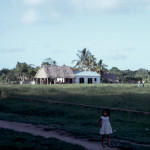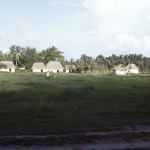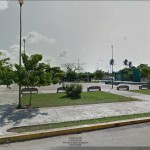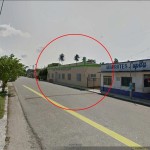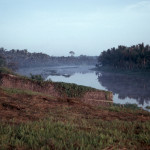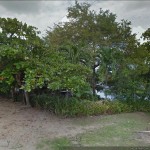I spent the summer of 1968 in the Chontalpa, a low lying coastal region of Tabasco, southern Mexico. For a couple of weeks I was in a small village (18.153669°, -93.742321°) that sits in a bend of the Rio San Felipe some 13 km inland from the Laguna del Carmen. Today this village is called Ignacio Gutiérrez Gómez, a name that honors a native son who became an early 20th century revolutionary hero. In 1968 most villagers still called it by an older name, San Felipe, and so it remains for me.
I recently turned to Google Earth to see how this village fared over the half century since my visit. I’m impressed by what I found. San Felipe today is a modern, prosperous looking town with a population of more than 2,000 people. However, the contrast between the village as it was in 1968 and the modern town is so dramatic that I decided to revisit the place in a blog post.
In 1968, San Felipe had roughly 200-300 inhabitants. Rainforest still covered most of the Chontalpa and the big drainage canals that were an important factor in opening up the region to development had only recently been cut. Even then, however, parts of the region had been cut over and coconut palm groves dotted the landscape from around San Felipe out to the lagoon.
One could reach the village on horseback, by truck, or a small bus called El Cardenal in dry weather along a rough dirt track; 4-wheel drive helped a lot if you made the trip during the rainy season. Another option, which was beginning to fall off in popularity in the ’60s, was to approach the village by cayuca or launch up the Rio San Felipe from the lagoon.
Most homes were traditional one or two room huts with thatched roofs. The church, school, several commercial buildings, a few homes, and the ramada under which the agente municipal conducted village business were proper buildings with tile or corrugated metal roofs. Spanish was the common language, followed, I think, by Chontal or Zoque Maya. I seldom heard a word of English in the village, but I recall that the owner of one small tienda had lived for a few years in Oregon and Los Angeles. Unlike the modern town of San Felipe, there were no paved streets, no electrical power other than a few gas-powered generators, and no running water. The village got pretty quiet after sundown, enough so that I was awakened more than once simply by the sound of a horse trotting by late at night.
Plaza or Town Square
The agente municipal let me string my hammock in an empty building on the west side of the village plaza. I furnished the building with a hammock, towel, flashlight, duffel bag, and big water bottle. I shared the front of the building for a couple of nights with an itinerant raspadero, or snow cone salesman. He moved on after he used up the ice he had brought with him from Cárdenas. Other than the snow cone man, it was just me and the bugs that were my alarm clock. Without fail they woke me up every morning as the sun heated up the building’s thatched roof where they had spent the night and they began to crawl down into the walls. The thatch was old and workmen began re-thatching the roof towards the end of my stay.
I got many of my meals, mostly black beans, rice, tortillas, fruit, and the occasional fried egg, from a small tienda/carnicería near my building. There was also I recall, a pool hall, a bakery shop, and at least one bar close to the plaza.
Click on a thumbnail below to see the full photo
In 1968 the village plaza was just a empty, grassy field bordered by a dirt path. The agente municipal‘s office and ramada were on the plaza’s north side. The same plaza today has attractive landscaping, is paved with walkways, and lined with park benches.
A scatter of thatched houses defined the east side of the plaza in 1968. More substantial buildings dominated the plaza’s west side.
In 1968 the main building on the south side of the plaza was the school, just as it is today. Once painted in cheerful, bright colors, the school now looks a bit more subdued.
Rio San Felipe
The river still played a role in 1960s village life, one that would quickly pass with the coming of better roads. A launch would occasionally come up from the coast at night with supplies for the tiendas. Most river traffic, however, was done by the cayucas that daily went to and from the village and across to the other bank.
One seldom saw more than one or two cayucas on the river at any given moment. Early one weekend morning, however, I was surprised to see a half dozen or more cayucas coming around the bend. As they pulled into shore near me, out hopped a baseball team, dressed in proper uniform and carrying all their gear. They’d come up, presumably from the coastal town of Sanchez Magallanes, for a game at San Felipe. If you’ve never seen a baseball team arrive for a game by cayuca, then you’ve missed quite a lot. This said, I remember nothing about the game itself, only the team’s impressive arrival.
The riverbank at San Felipe was a beautiful spot dotted with thatch-roofed cayuca sheds, one of which can be seen in the center of the 1968 river photo. The view, the sheds, and, apparently, the cayucas are gone now.
The dirt track that ran north from the plaza was an important thoroughfare that ended at the river bank. It’s now a paved street lined with homes.
Then and Now
Google Earth shows that the region around San Felipe has undergone remarkable changes since the 1960s. The entire Chontalpa is now a network of good roads, agricultural fields, and prosperous looking towns. The price was the rainforest, which was cut away; only about 4% of it remains. The forest was beautiful and I’m delighted to have known it. A troop of howler monkeys shouting at the early morning sun as it peeked over the forest edge remains one of my favorite memories; it is as fresh in my mind as though it happened a few moments ago. This said, I entirely understand that the forest had to go and low-lying land had to be drained if communities like San Felipe were to grow.
My visit to San Felipe was my first experience as a foreigner in a small, traditional, closed community. Most villagers ignored me and I suspect that the others simply wished that I’d just go away. Regrettably, small children paid me all too much attention and I often fell asleep to, or was awaken by, the sound of giggles and “Psst, Gringo, Gringo, psst, Gringo”. That part was a bit wearing. I reminded myself that, were the situation reversed, a young Mexican would fare no better in my small home town in Mississippi. He could easily be less kindly received.
Other lessons were particularly light hearted. Take, for example, when I went to draw bath water from a well on my first evening in the village. The process was both simple and obvious – take up the pail sitting on the lip of the well, hold the rope tied to pail’s bail, chuck the pail in the well, then haul up the water. Simple, right? Well, uh, no. I lowered the pail down to the water and watched helplessly as it bobbed around without a drop in it. Try as I may I could not get the pail to tip over. Pull it up and lower it again. Same result. Look carefully at pail, rope, and well. Try yet again without luck. Provide considerable comic relief for the pint-size Mayan grandmother standing in the doorway of her home watching me. Finally, after she’s had her laugh, she takes pity on me and walks over, wordlessly takes the rope out of my hands, pushes me away, and motions me to watch. She lowers the pail down the well, gives the rope a light flick, and “plop”, the pail flips over and plunges into the water. Amazing. She hauls up the pail, empties out the water, rests the pail on the lip of the well, and walks back to her doorway. I try to imitate her and eventually succeed. I look up at her but she ignores me. A basic life skill learned – it’s all in the wrist.
The citizens of San Felipe have clearly worked hard and with great success to build a nice looking town. I wish them well for the future.

